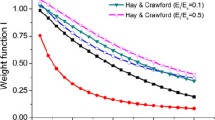Abstract
The indentation technique is widely used in measuring the mechanical properties of soft matter at the microscale or nanoscale, but still faces challenges by these unique properties as well as the consequent strong surface adhesion, including the strong nonlinear effect, unclear judgment of the contact point, difficulties in estimating the contact area, and the risk of the indenter piercing the sample. Here we propose a two-step method to solve these problems: lay a hard film on a soft matter, and obtain the viscoelastic properties of this soft matter through the indentation response of this composite structure. We first establish a theoretical indentation model of the hard film-soft substrate system based on the theory of plates, elastic-viscoelastic correspondence principle and Boltzmann superposition principle. To verify the correctness of this method, we measure the mechanical properties of the methyl vinyl silicone rubber (MVSR) covered by a Cu nanofilm. Finally, we test the effectiveness and error sensitivity of this method with the finite element method (FEM). The results show that our method can accurately measure the mechanical properties of soft matter, while effectively circumventing the problems of the traditional indentation technique.
Similar content being viewed by others
References
M. Fang, Z. Zhang, J. Li, H. Zhang, H. Lu, and Y. Yang, J. Mater. Chem. 20, 9635 (2010).
Z. Chen, and H. Lu, J. Mater. Chem. 22, 12479 (2012).
Z. Yin, S. Sun, T. Salim, S. Wu, X. Huang, Q. He, Y. M. Lam, and H. Zhang, ACS Nano 4, 5263 (2010).
A. Castellanos-Gomez, M. Poot, G. A. Steele, H. S. J. van der Zant, N. Agraït, and G. Rubio-Bollinger, Adv. Mater. 24, 772 (2012).
D. H. Ho, Q. Sun, S. Y. Kim, J. T. Han, D. H. Kim, and J. H. Cho, Adv. Mater. 28, 2601 (2016).
A. Nautiyal, M. Qiao, J. E. Cook, X. Zhang, and T. S. Huang, Appl. Surf. Sci. 427, 922 (2018).
A. S. Mijailovic, B. Qing, D. Fortunato, and K. J. Van Vliet, Acta Biomater. 71, 388 (2018).
Z. Tan, S. Chen, X. Peng, L. Zhang, and C. Gao, Science 360, 518 (2018).
J. A. Rogers, T. Someya, and Y. Huang, Science 327, 1603 (2010).
D. E. Discher, P. Janmey, and Y. L. Wang, Science 310, 1139 (2005).
S. E. Cross, Y. S. Jin, J. Tondre, R. Wong, J. Y. Rao, and J. K. Gimzewski, Nanotechnology 19, 384003 (2008).
J. F. Chen, K. J. Xu, L. Q. Tang, Z. J. Liu, and L. C. Zhou, Mech. Mater. 119, 42 (2018).
Y. T. Cheng, W. Ni, and C. M. Cheng, Phys. Rev. Lett. 97, 075506 (2006).
S. C. Hunter, J. Mech. Phys. Solids 8, 219 (1960).
Y. T. Cheng, and C. M. Cheng, Appl. Phys. Lett. 87, 111914 (2005).
L. Cheng, X. Xia, W. Yu, L. E. Scriven, and W. W. Gerberich, J. Polym. Sci. B Polym. Phys. 38, 10 (2000).
L. Cheng, X. Xia, L. E. Scriven, and W. W. Gerberich, Mech. Mater. 37, 213 (2005).
Y. T. Cheng, and C. M. Cheng, Philos. Mag. Lett. 81, 9 (2001).
M. M. Chaudhri, Acta Mater. 46, 3047 (1998).
M. Dao, N. Chollacoop, K. J. Van Vliet, T. A. Venkatesh, and S. Suresh, Acta Mater. 49, 3899 (2001).
M. R. Van Landingham, N. K. Chang, P. L. Drzal, C. C. White, and S. H. Chang, J. Polym. Sci. B Polym. Phys. 43, 1794 (2005).
G. M. Odegard, T. S. Gates, and H. M. Herring, Exp. Mech. 45, 130 (2005).
M. E. McConney, S. Singamaneni, and V. V. Tsukruk, Polym. Rev. 50, 235 (2010).
Y. Liu, Y. Wei, and P. Chen,Int. J. Mech. Sci. 151, 214 (2019).
G. Cao, Y. Liu, and T. Niu, Int. J. Mech. Sci. 137, 96 (2018).
Y. Liu, Y. Wei, and P. Chen, Soft Matter 15, 5760 (2019).
G. M. Pharr, and W. C. Oliver, MRS Bull. 17, 28 (1992).
S. Suresh, T. G. Nieh, and B. W. Choi, Scripta Mater. 41, 951 (1999).
D. Y. W. Yu, and F. Spaepen, J. Appl. Phys. 95, 2991 (2004).
X. Wei, D. Lee, S. Shim, X. Chen, and J. W. Kysar, Scripta Mater. 57, 541 (2007).
R. Whiting, and M. A. Angadi, Meas. Sci. Technol. 1, 662 (1990).
M. T. Lin, C. J. Tong, and K. S. Shiu, Exp. Mech. 50, 55 (2010).
J. Y. Park, S. J. Yoo, E. J. Lee, D. H. Lee, J. Y. Kim, and S. H. Lee, BioChip J. 4, 230 (2010).
D. S. Um, S. Lim, Y. Lee, H. Lee, H. Kim, W. C. Yen, Y. L. Chueh, and H. Ko, ACS Nano 8, 3080 (2014).
C. Ganser, C. Czibula, D. Tscharnuter, T. Schöberl, C. Teichert, and U. Hirn, T. Soft Matter 14, 140 (2017).
Author information
Authors and Affiliations
Corresponding author
Additional information
This work was supported by the National Natural Science Foundation of China (Grant Nos. 11432014, 11521202, 11672301, and 11890681).
Rights and permissions
About this article
Cite this article
Liu, Y., Wei, Y. & Long, H. Identifying the viscoelastic properties of soft matter from the indentation response of a hard film-soft substrate system. Sci. China Phys. Mech. Astron. 63, 244612 (2020). https://doi.org/10.1007/s11433-019-1482-y
Received:
Accepted:
Published:
DOI: https://doi.org/10.1007/s11433-019-1482-y




